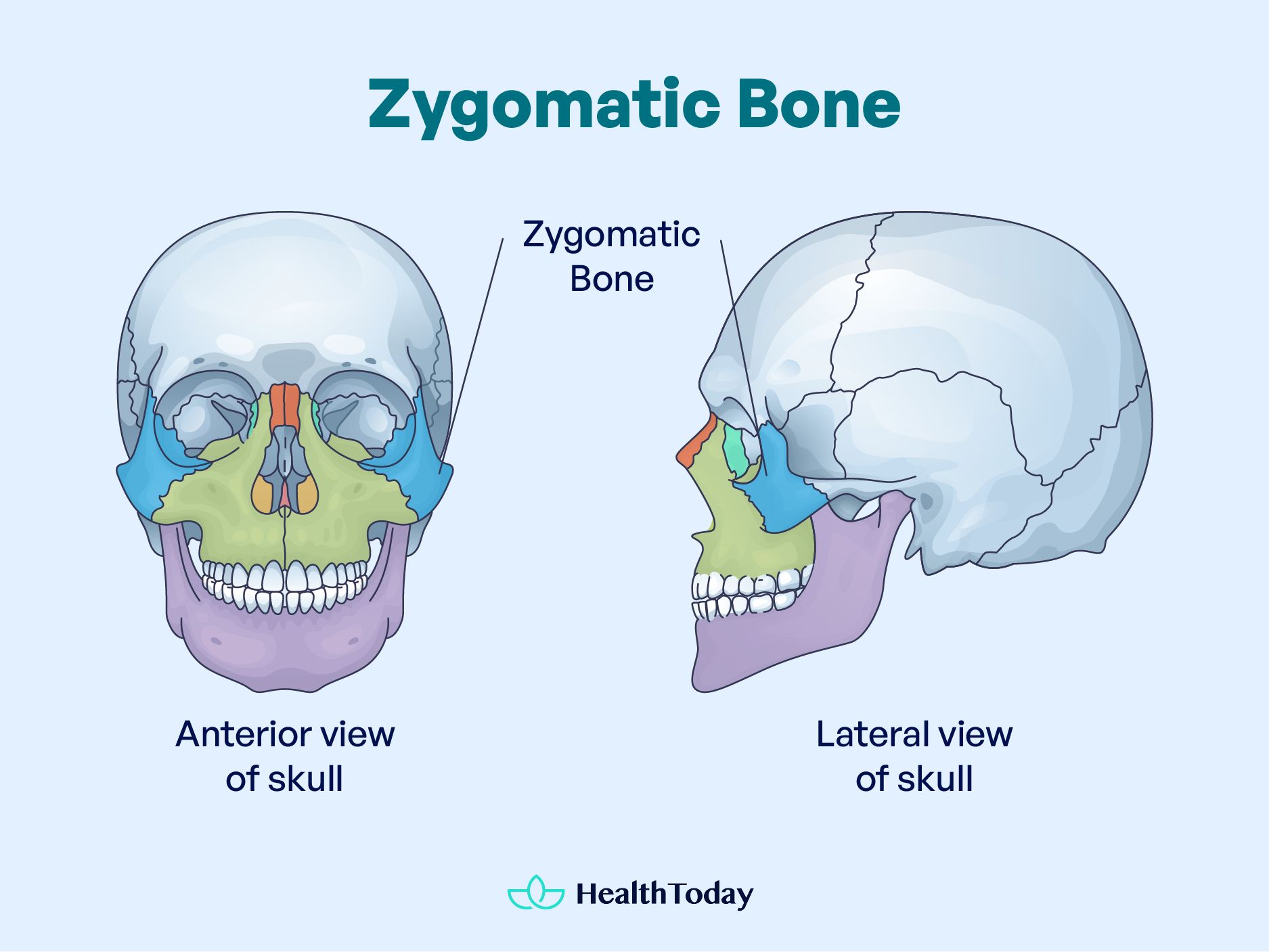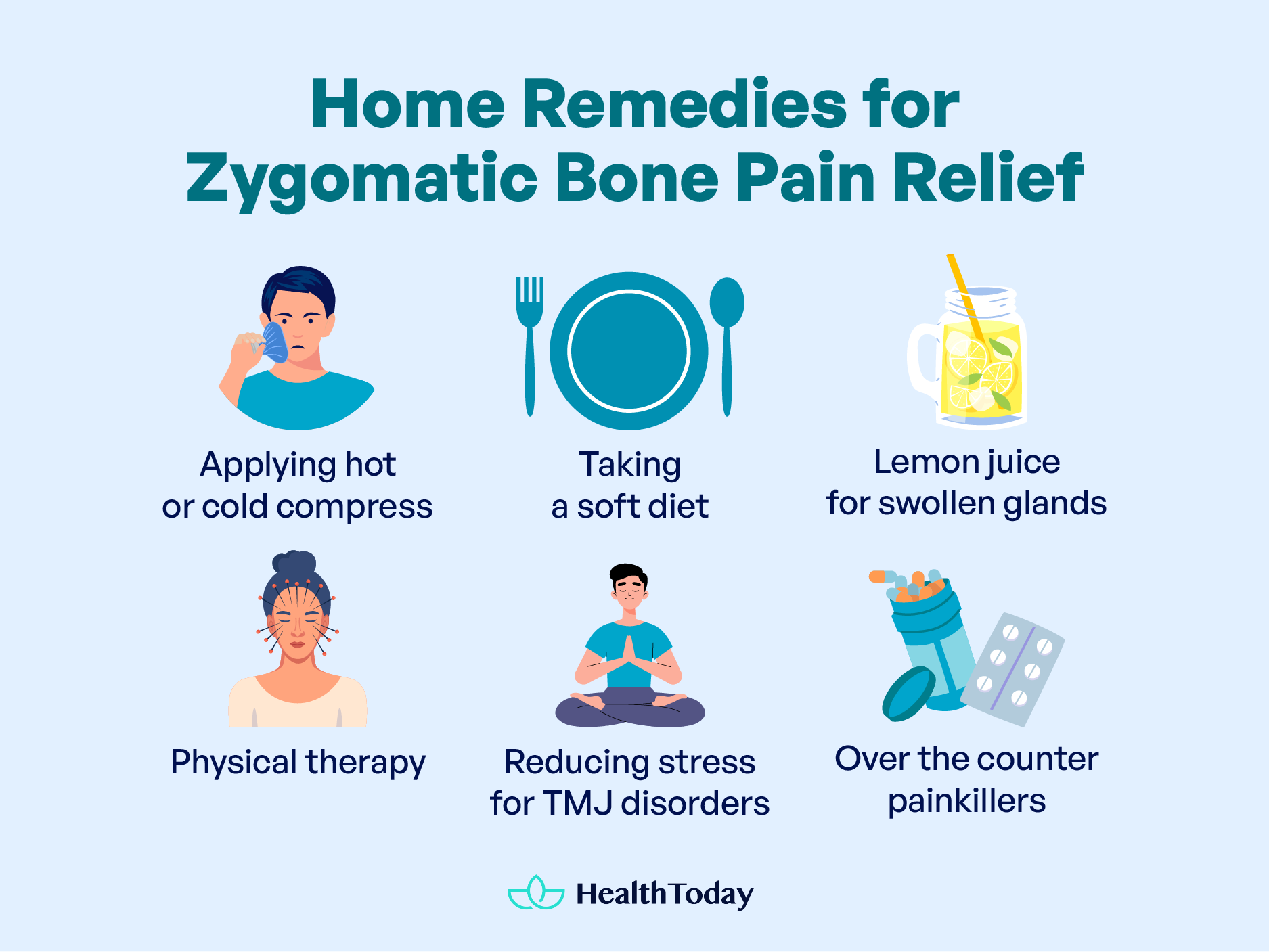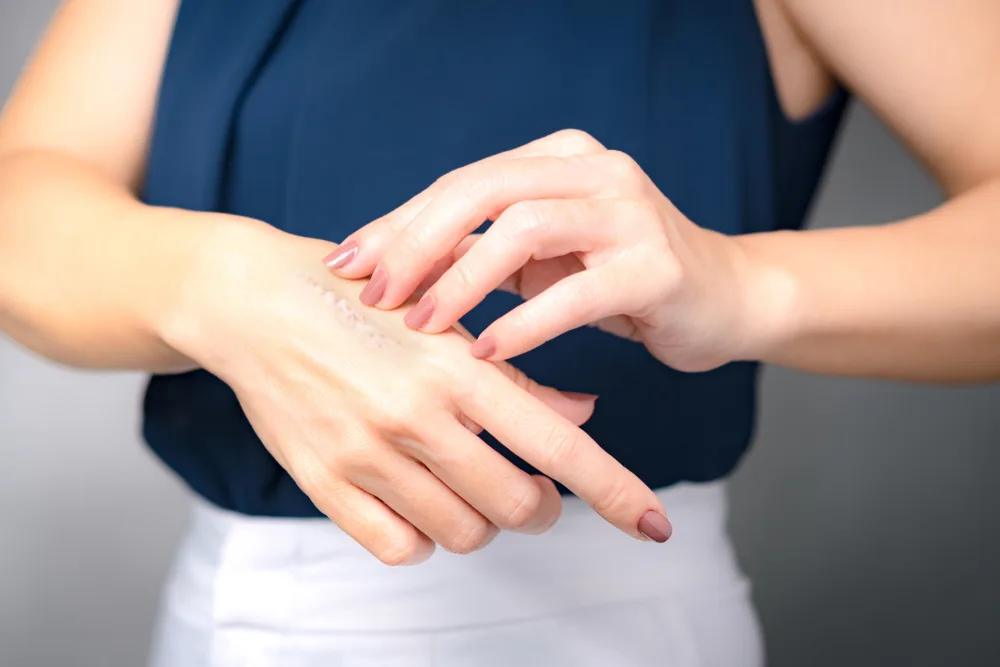Table of Contents
Do you know what your cheekbone is called medically? Did you ever notice it gets injured commonly in facial traumas? Cheekbone, also known as zygomatic bone, has several important roles.
From the red flags of zygomatic bone pain to when you should visit your doctor? What can you try at home to have an immediate relief of zygomatic bone pain and what should you expect from your doctor to diagnose the exact cause of pain? All of these questions will be explained in detail in this article.
What is zygomatic bone pain and its causes?
Before going into the details of zygomatic bone pain, you should know where the zygomatic bone is located and what it is.
Zygomatic bone pain: What is it, and where is it located?
Zygomatic bones are paired bones located on both sides of the face. They form the anterior and lateral portions of facial bones. They protect and surround the region of the face, which contains eye and eye contents (orbits). They are commonly known as cheekbones (1).

The zygomatic bone is the most commonly fractured in traumatic events. It affects not only the cheek area but also causes injury to the eye socket and distortion of midface architecture (1).
Zygomatic bones are irregular in shape and have a protrusion at the lateral aspect of the face, known as the zygomatic arch. Not only the zygomatic bone but also the zygomatic arch can get hurt due to various reasons. These reasons include local trauma and radiating pain from remote areas (1).
The zygomatic bone is very important as it helps in mastication (or the chewing of food). It balances the pressures among various cheek muscles and bones during chewing. It is significant in maintaining the aesthetics of the face and serves as a connecting bone between facial and skull bones (1).
The Zygomatic bone is attached to other facial bones at various points. Fracture of bone occurs at these points, which include the joining points of the zygomatic and frontal bone—forehead bones. This joining point is at the lateral area of eye sockets (2).
Other prone areas to fractures are zygomatic and maxillary bone junctions. Maxillary bones are also paired bones on both sides of the face at the side of the nose and form the major portion of the upper jaw (3). The damage here can result in distortion of the midface and upper jaw (1).
However, the reason for pain in the zygomatic bone area and its connections is not only the trauma or fracture; there are various medical reasons, as discussed below.
Possible causes of zygomatic bone pain
First, we will discuss the consequences of the zygomatic bone and its arch’s fractures (4):
- Cheek area pain
- Paresthesia (numbness) in areas supplied by a nerve named the maxillary nerve. Fractures of zygomatic bone can damage the maxillary nerve and hence affect the areas supplied by it. It supplies the middle third of the face and tear-producing glands (5).
- Double vision, known as diplopia
- Flattening of the cheek area
- Difficulty in opening jaw
- Bleeding around the eyes and under the conjunctiva of the eye; Conjunctiva covers the white part of the eye and also lines inside the eyelid (6).
- Chewing disorder
- Protrusion of eye contents known as exophthalmos
- Retraction of eye content, known as enophthalmos
- Bleeding from the nose on that side
- Facial swelling and hematomas
Other than bone fracture, pain in the zygomatic bone can be felt due to referred pain. Referred pain is the pain that is felt at one place due to the problem at another place. This happens because the same nerve is supplying both areas (7).
It has been seen that sometimes you feel pain in your cheekbone, while the cause may relate to oral or facial pathology. It is very important to diagnose the right cause to treat it properly (7).
The following are the conditions that can cause cheekbone pain (7):
- Myofascial pain: It’s a disorder of chewing muscles that causes pain in the zygomatic area. The pain is usually dull and continuous, associated with headaches. It can be diagnosed with muscle palpation.
- Myositis: Inflammation of chewing muscles. It can cause difficulty opening the mouth and is diagnosed with MRI or CT imaging. The pain is throbbing in nature and moderate to severe in intensity.
- Tooth pathologies: Dental disorders, particularly in upper jaw teeth, can cause pain in the cheek area, and its intensity varies depending upon the exact etiology. It is diagnosed with oral examination and plain radiographs.
- Neuropathic pain: Pain due to disorders of cranial nerves or at the level of the brain can cause sharp, stinging pain in the zygomatic area. It is diagnosed with physical examination and radiological investigations of the brain if necessary.
- Sinusitis: Sinuses are hollow spaces on both sides of the face inside the facial bones. If a sinus gets infected, it is called sinusitis. The pain of maxillary sinusitis (maxillary sinus is present in the midface—above the upper jaw) can radiate to the zygomatic bone area and feel like dull, continuous pain. It is associated with post-nasal drip, nasal discharge, headaches, and changes in taste sensation.
- Salivary gland tumors: Benign or malignant growth of saliva-producing glands or even infections of salivary glands can cause stabbing cheekbone pain. It is diagnosed with extensive radiological investigations, including PET scan, CT scan, or MRI.
- Coronary artery disease: If you are experiencing chest pain or heart disease, pain may radiate to cheekbones. It is a less common presentation of heart attack but can occur. Other associated symptoms are dizziness, nausea, lightheadedness, or weakness (8).
TMJ disorders: Temporomandibular joint disorders are a common cause of cheekbone pain. TMJ disorders result from grinding teeth and also from facial muscle strain. There are many causes of TMJ, including clinical, psychological, sensory, genetic, and nervous system factors. It can be diagnosed from physical examination and relieved by painkillers and stress relieving techniques (8).
Zygomatic bone, also known as cheekbone, plays an important role in facial aesthetics, chewing, and protecting eyes. It is the connection between facial bones with skull bones. It can get fractured during fights and accidents. Symptoms of a zygomatic fracture include double vision, sinking or protrusion, eye protrusion, bleeding in the eyes, flattening of the face, and difficulty in opening the jaw. Various medical disorders also cause zygomatic bone pain, including chewing muscle disorders, dental diseases, sinusitis, neuropathic pain, TMJ disorders, and salivary gland disorders.
When should I visit the doctor?
Cheekbone pain is usual, but the important question is should we go for a checkup every time we have zygomatic bone pain, or if you get some symptoms that are particularly alarming?
Following are the associated symptoms with cheekbone pain that should not be ignored (4, 8, 9):
- Pain or tenderness at the site of trauma may indicate fracture and warrant urgent surgical or non-surgical stabilization of bones.
- Visible deformity of midface or cheeks: It indicates displacement of bones
- Facial swelling: It signals blood clot collection at the injury site or pus collection in case of infection.
- Redness and bruising
- Fever, chills, features of sinusitis such as post nasal drip, headache, and nasal discharge
- Trismus: difficulty in opening the jaw, diplopia, and double vision. These signs indicate deeper injury or infection and a sign that you should visit your doctor.
- If you have chest pain associated with jaw and cheek pain, it indicates a heart disorder and requires you to visit your doctor.
- Loose teeth or if your upper and lower jaw do not align.
- Open wound where underlying cheekbone is visible
- If there are no visible alarming symptoms, but you still have zygomatic bone pain that lasts for a few days, you will need specialist attention because pain due to benign nature should go away within a few days.
Your doctor may perform the following tests to diagnose your condition (7):
- Muscle palpation
- CT scan of face and skull
- MRI of face and skull
- PET scan
- Intra-oral Examinations
- Intranasal Examinations
- Ultrasonography
- X-rays
If zygomatic bone pain lasts for too long, you should consult with a doctor. Alarming signs of cheekbone pain include visible deformity, facial swelling, protrusion or sinking of eyes, difficulty in jaw opening, high-grade fever, and double vision.
Your healthcare provider may perform local examinations and order radiological investigations to diagnose the exact cause and decide the treatment for you.
Home remedies for zygomatic bone pain relief

If you have some symptoms, as discussed above, you should consult with a specialist as soon as possible. But we can try simple home remedies for the pain of a benign nature:
- If you have a mild fever and mild nasal discharge along with zygomatic bone pain, it may indicate early stage sinusitis as described above. The cause can be a viral infection, for which you can take steam inhalation or nasal saline. Over-the-counter painkillers and anti-allergy medications also help relief. If it does not resolve with these measures, don’t forget to visit your doctor (8, 10).
- In case of pain due to teeth grinding, you can try physical therapy, exercises, a good night’s sleep, and meditation along with a night guard (11).
- Sometimes, the pain is due to disorders of the salivary gland, such as sialadenitis (swollen salivary glands), the most prominent symptom of which is increased pain while eating. Lemon juice and hard candy can help release saliva and reduce swelling (8).
If you are awaiting a doctor’s visit, the following measures can help minimize further damage (8):
- Applying a hot or cold compress to the cheek
- Taking a soft diet
- Mouth guard at night
- Avoid having chewing gum
In short, you can use your mouth but with caution (8).
What causes zygomatic swelling?
Sometimes infections from the middle ear or the mastoid (bony area behind the ear) can travel to the zygomatic bone (cheekbone), causing swelling. This swelling is known as zygomatic abscess (12). Trauma on the face resulting in zygomatic fractures, can also cause zygomatic swelling. After surgical repair of these fractures, post-operative infection can result in swelling (9, 13).
What muscle is attached to the zygomatic bone?
Zygomatic bone provides attachment to chewing muscles. Particularly noticeable is the masseter muscle, which is important in mastication, and its origin is from the zygomatic bone. Temporalis muscle is also associated with zygomatic bone (1).
What happens if the zygomatic bone is damaged?
Zygomatic bone protects the eyes, maintains the aesthetics of the face, and helps in chewing. Damage or fracture to zygomatic bone can result in a range of symptoms, including difficulty in jaw opening, sinking of eyes or their protrusion, cheek pain, bleeding from eyes or nose, facial swelling, double vision, and disfigurement of the midface (4).
What are the nerves around the zygomatic bone?
The facial nerve is the seventh cranial nerve. It has five branches—Two of these branches are associated with zygomatic bone. These include zygomatic and buccal branches. The trigeminal nerve is the fifth cranial nerve. The maxillary division of the trigeminal nerve is associated with zygomatic bone and gives off branches in the zygomatic bone area. Further branches of these nerves mostly supply the oral cavity, eyelid muscles, and midface area (1).
Does smiling help the jawline?
Occasional smiling does not produce a significant effect. But smiling exercises that involve smiling repeatedly in a specific pattern can help with double chin and improving facial contours. This is because smiling can stimulate almost all facial muscles, and repeated smiling exercises can give your face an aesthetic composition (14).
Zygomatic bone, also known as cheekbone, can get fractured easily in facial traumas. Symptoms include cheek pain, double vision, flattening of the face, difficulty opening the jaw, and retraction or protrusion of the eyes. Sometimes pain in zygoma can be felt due to radiation from remote areas, such as dental caries, salivary gland tumors, chewing muscles inflammation, and TMJ disorders; all of them can cause pain in the cheekbone.
Red flags include facial bruising, fever, chills, tenderness, and open wounds on the cheek. A doctor should evaluate the alarming signs. Some home remedies for relieving pain are cold or hot compress, soft diet and night guard.

















Comments
0